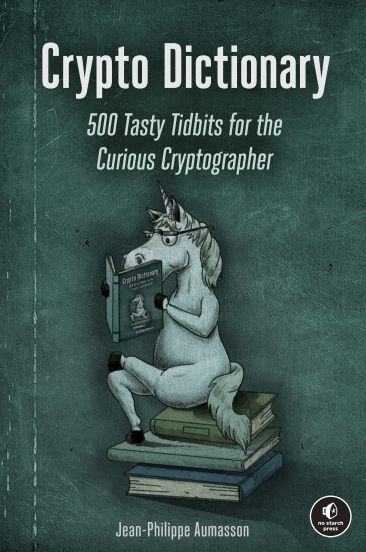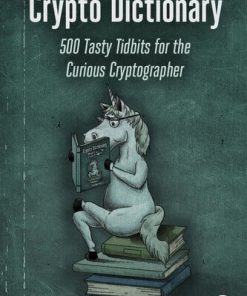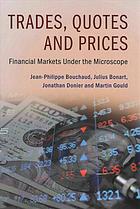Crypto Dictionary 500 Tasty Tidbits for the Curious Cryptographer 1st Edition by Jean Philippe Aumasson 1718501416 9781718501416
$50.00 Original price was: $50.00.$25.00Current price is: $25.00.
Crypto Dictionary: 500 Tasty Tidbits for the Curious Cryptographer 1st Edition by Jean-Philippe Aumasson – Ebook PDF Instant Download/DeliveryISBN: 1718501416, 9781718501416
Full download Crypto Dictionary: 500 Tasty Tidbits for the Curious Cryptographer 1st Edition after payment.

Product details:
ISBN-10 : 1718501416
ISBN-13 : 9781718501416
Author: Jean Philippe Aumasson
Rigorous in its definitions yet easy to read, Crypto Dictionary covers the field of cryptography in an approachable, and sometimes humorous way. Expand your mind and your crypto knowledge with the ultimate desktop dictionary for all things cryptography. Written by a renowned cryptographer for experts and novices alike, Crypto Dictionary is rigorous in its definitions, yet easy to read and laced with humor. Flip to any random page to find something new, interesting, or mind-boggling, such as: • A survey of crypto algorithms both widespread and niche, from RSA and DES to the USSR’s GOST cipher • Trivia from the history of cryptography, such as the MINERVA backdoor in Crypto AG’s encryption algorithms • An explanation of why the reference to the Blowfish cipher in the TV show 24 makes absolutely no sense • Types of cryptographic protocols like zero-knowledge; security; and proofs of work, stake, and resource • A polemic against referring to cryptocurrency as “crypto” • Discussions of numerous cryptographic attacks, including slide and biclique The book also looks toward the future of cryptography, with discussions of the threat quantum computing poses to current cryptosystems and a nod to post-quantum algorithms, such as lattice-based cryptographic schemes. With hundreds of incisive entries organized alphabetically, Crypto Dictionary is the crypto go-to guide you’ll always want within reach.
Crypto Dictionary: 500 Tasty Tidbits for the Curious Cryptographer 1st Table of contents:
- A
- A5/0
- A5/1
- A5/2
- A5/3
- A5/4
- Adaptive attack
- AEAD (authenticated encryption with associated data)
- AES (Advanced Encryption Standard)
- AES-CCM
- AES-GCM
- AES-GCM-SIV
- AES-NI
- AES-SIV
- AIM (Advanced INFOSEC Machine)
- AKA
- AKS (Agrawal–Kayal–Saxena)
- Algebraic cryptanalysis
- Alice
- All-or-nothing transform (AONT)
- Anonymous signature
- Applied Cryptography
- Applied cryptography
- ARC4
- Argon2
- ARX (Add-Rotate-XOR)
- ASIACRYPT
- Asymmetric cryptography
- Attack
- Attribute-based encryption (ABE)
- Authenticated cipher
- Axolotl
- B
- Backdoor
- Backtracking resistance
- Backward secrecy
- Base64
- BassOmatic
- BB84
- bcrypt
- Biclique cryptanalysis
- BIKE (Bit Flipping Key Encapsulation)
- BIP (Bitcoin improvement proposal)
- Bit Gold
- Bitcoin
- Black
- BLAKE
- BLAKE2
- BLAKE3
- Bleichenbacher attack
- Blind signature
- Block cipher
- Blockchain
- Blockcipher
- Blowfish
- BLS (Boneh-Lynn-Shacham) signature
- Bob
- Boolean function
- Boomerang attack
- BQP (bounded-error quantum polynomial time)
- Braid group cryptography
- Brainpool curves
- Break-in recovery
- Broadcast encryption
- Brute-force attack
- Bulletproof
- Byzantine fault tolerance
- C
- CAESAR
- Caesar’s cipher
- CAVP (Cryptographic Algorithm Validation Program)
- CBC (cipher block chaining)
- CECPQ (combined elliptic-curve and post-quantum)
- Cellular automata
- Ceremony
- Certificate
- Certificate authority (CA)
- Certificate transparency (CT)
- ChaCha20
- CHES (Conference on Cryptographic Hardware and Embedded Systems)
- CIA
- Ciphertext stealing
- Clipper
- CMVP (Cryptographic Module Validation Program)
- Code-based cryptography
- Commitment
- Concurrent zero-knowledge
- Consensus protocol
- Control word
- COPACOBANA (Cost-Optimized PArallel COde Breaker)
- Cothority (collective authority)
- Cryptanalysis
- Cryptids
- Crypto
- CRYPTO
- Crypto AG
- Crypto period
- Crypto variable
- Crypto wars
- Cryptobiosis
- Cryptocurrency
- Crypto-Gram
- Cryptography
- Cryptologia
- Cryptology
- Cryptonomicon
- Cryptorchidism
- Cryptovirology
- CRYPTREC
- CSIDH (Commutative Supersingular Isogeny Diffie–Hellman)
- CTF (capture the flag)
- Cube attack
- Curve25519
- Curve448
- Cypher
- D
- Daemon
- Davies–Meyer
- Decentralized private computation
- Déchiffrer
- Décrypter
- Deniable encryption
- DES (Data Encryption Standard)
- Dictionary
- Dictionary attack
- Differential cryptanalysis
- Diffie–Hellman
- Disclosure
- Discrete logarithm problem
- Distinguisher
- Distributed randomness
- Dolev–Yao model
- Double ratchet
- Dragonfly
- DRBG (deterministic random bit generator)
- DSA (Digital Signature Algorithm)
- DSS (Digital Signature Standard)
- DVB-CSA
- E
- E0
- ECB (electronic codebook)
- ECC
- ECDLP (Elliptic-curve discrete logarithm problem)
- ECDSA (Elliptic-curve DSA)
- ECIES (Elliptic-curve IES)
- Ed25519
- EdDSA
- EKMS (Electronic Key Management System)
- Electronic codebook
- ElGamal
- Elligator
- Elliptic curve
- Elliptic-curve cryptography
- Encipherment
- End-to-end encryption (E2EE)
- Enigma
- Entropy
- ePrint
- Erathosthenes’ sieve
- eSTREAM
- Ethereum
- Eurocrypt
- Eve
- E-voting
- F
- Factoring problem
- Feedback shift register
- Feistel network
- Fialka (Фиалка)
- Fiat–Shamir
- FIPS 140-2
- FIPS 140-3
- Forgery
- Formal verification
- Format-preserving encryption
- Forward secrecy
- FOX
- FSE (Fast Software Encryption)
- Fully homomorphic encryption
- Functional encryption
- Future secrecy
- Fuzzy extractor
- G
- Generalized birthday problem
- GNFS (General Number Field Sieve)
- GOST
- Grain
- Gröbner basis
- Group signature
- Grover’s algorithm
- H
- Hardcore predicate
- Hash function
- Hash-based cryptography
- Heartbleed
- Hedged signature
- HFE (Hidden Field Equations)
- HMAC (Hash-based MAC)
- Homomorphic encryption
- HPC (Hasty Pudding Cipher)
- HSM (hardware security module)
- HTTP/3
- Hyperelliptic-curve cryptography
- I
- IACR (International Association for Cryptologic Research)
- IDEA (International Data Encryption Algorithm)
- IDEA NXT
- Identity-based encryption
- IES (Integrated Encryption Scheme)
- Impatient saboteur
- Impossibility
- Impossible differential attack
- IND-CCA
- IND-CPA
- Indelibility
- Indifferentiability
- Indistinguishability
- Indistinguishability obfuscation (iO)
- Information-theoretic security
- INT-CTXT
- Invisible signature
- IOTA
- IPES (Improved Proposed Encryption Standard)
- IPSec
- ISO standard
- Isogeny-based cryptography
- J
- Journal of Cryptology (JoC)
- K
- KASUMI
- Keccak
- KeeLoq
- KEM (key encapsulation mechanism)
- Kerberos
- Kerckhoffs’ principles
- Key derivation function (KDF)
- Key escrow
- Key management
- Key wrapping
- Kleptography
- Known-key attack
- Kupyna (Купина)
- L
- Laconic zero-knowledge proof
- Lai–Massey
- Lamport signature
- Lattice-based cryptography
- Le Chiffre
- Leakage-resilient cryptography
- Learning with errors (LWE)
- Length extension attack
- Length-preserving encryption
- LFSR (linear feedback shift register)
- Lightweight cryptography
- Linear cryptanalysis
- Linkability
- LM hash
- Luby–Rackoff
- Lucifer
- M
- MAC (message authentication code)
- MAGENTA
- Malleability
- Manger attack
- Man-in-the-middle
- MASH (Modular Arithmetic Secure Hash)
- McEliece encryption scheme
- MD4
- MD5
- MDC (Message Digest Cipher)
- MDC-2 (Modification Detection Code 2)
- Meet-in-the-middle
- Merkle puzzle
- Merkle tree
- Merkle–Damgård construction
- Mersenne twister
- Message franking
- Miller–Rabin
- MINERVA
- Mining
- Misuse resistance
- Mixnet
- MQV (Menezes–Qu–Vanstone)
- Multicollision
- Multi-party computation (MPC)
- Multivariate cryptography
- N
- NBS (National Bureau of Standards)
- NESSIE (New European Schemes for Signatures, Integrity, and Encryption)
- “New Directions in Cryptography”
- NFSR (nonlinear feedback shift register)
- NIST (National Institute of Standards and Technology)
- NIZK (non-interactive zero-knowledge)
- Noekeon
- Noise
- Nonce
- Non-committing encryption
- Non-outsourceability
- Non-slanderability
- NSA (National Security Agency)
- NT hash
- NTRU (Nth degree Truncated polynomial Ring Units)
- Null cipher
- O
- OAEP (Optimal Asymmetric Encryption Padding)
- Oblivious key management system (OKMS)
- Oblivious PRF (OPRF)
- Oblivious RAM (ORAM)
- Oblivious transfer
- Obscurity
- OCB (offset codebook mode)
- One-time pad
- One-way function
- Onion-AE
- OPAQUE
- OpenSSL
- Oracle
- OTR (Off-the-Record)
- P
- Padding oracle attack
- Paillier cryptosystem
- Pairing
- Pairing-based cryptography
- PAKE (password-authenticated key exchange)
- Paradigm
- Password hash function
- PBKDF2 (Password-Based Key Derivation Function 2)
- PCT (Private Communications Technology)
- PEP (Plaintext equivalence proof)
- Perfect forward secrecy
- Permutation-based cryptography
- PES (Proposed Encryption Standard)
- PET (Plaintext equivalence test)
- PFS
- PGP (Pretty Good Privacy)
- Photuris
- Picnic
- PKC
- PKCS (Public Key Cryptography Standards)
- Poly1305
- Polynomial complexity
- Post-compromise security
- Post-quantum cryptography
- Post-quantum RSA
- Prediction resistance
- Preimage
- PRESENT
- PRIMES
- Privacy-preserving
- Private information retrieval (PIR)
- Proof of burn
- Proof of catalytic space
- Proof of human work
- Proof of replication
- Proof of reserve
- Proof of security
- Proof of sequential work
- Proof of space
- Proof of spacetime
- Proof of stake
- Proof of storage
- Proof of useful work
- Proof of work
- Provable security
- Provably secure
- Proxy re-encryption
- Pseudo-random
- Pseudorandom function (PRF)
- Pseudorandom number generator (PRNG)
- Pseudorandom permutation (PRP)
- Public-key cryptography
- PUF (physically unclonable function)
- Puncturable encryption
- Puncturable pseudorandom function (PPRF)
- Q
- Quantum computer
- Quantum cryptography
- Quantum encryption
- Quantum key distribution
- Quantum signature
- QUIC (Quick UDP Internet Connections)
- R
- Rabin cryptosystem
- Rainbow tables
- Random bits
- Random oracle
- Randomness
- Range proof
- RC4
- RC5
- RC6
- Real world
- Real World Crypto (RWC)
- Rectangle attack
- Related-key attack
- Research papers
- Revocation
- Rijndael
- Ring signature
- RIPEMD-160
- Rivest–Shamir–Adleman
- ROBOT (Return Of Bleichenbacher’s Oracle Threat)
- ROS
- RSA
- Rubber-hose cryptanalysis
- Rumba20
- S
- SAEP (Simplified OAEP)
- Salsa20
- Sandwich attack
- S-box
- Scalar
- sci.crypt
- Scrambler
- scrypt
- Searchable encryption
- secp256k1
- Secret sharing
- Security
- Security proof
- Semantic security
- Serious Cryptography
- Serpent
- SHA-0
- SHA-1
- SHA-2
- SHA-3
- SHA-3 competition
- SHACAL
- Shamir’s secret database
- Shor’s algorithm
- SHS (Secure Hash Standard)
- Side channel
- Side-channel attack
- Sigaba
- Signal protocol
- Signature
- Signcryption
- SIKE (Supersingular Isogeny Key Encapsulation)
- SIMECK
- SIMON
- SipHash
- SIV-AES
- Skipjack
- Slide attack
- SM
- Smart contract
- Snake-oil
- SNARK (succinct non-interactive argument of knowledge)
- SNIP (secret-shared non-interactive proof)
- SNOW 3G
- Solitaire
- SPECK
- SPEKE (Simple Password Exponential Key Exchange)
- SPHINCS
- Sponge function
- SRP (Secure Remote Password)
- SSH (Secure Shell)
- SSL (Secure Socket Layer)
- STARK (scalable transparent arguments of knowledge)
- Steganography
- Stream cipher
- Substitution-permutation network (SPN)
- Suck
- Sugar beet auctions
- Suite A
- SUPERCOP
- Superpolynomial complexity
- SVP (shortest vector problem)
- Symmetric-key cryptography
- T
- TCC
- Test vectors
- Threefish
- Threshold encryption
- Threshold secret-sharing
- Threshold signature
- Time AI™
- Time-lock encryption
- Time-lock puzzle
- Timing attack
- TLS (Transport Layer Security)
- Tor
- Traitor tracing
- Transfinite cryptography
- Trapdoor
- Triple DES
- Trivium
- True random number generator (TRNG)
- Trusted third party
- Tweakable block cipher
- Twofish
- U
- Undeniable signature
- Universal composability
- Universal hash function
- Updatable encryption
- V
- Verifiable delay function (VDF)
- Verifiable random function (VRF)
- Verifiable unpredictable function (VUF)
- Vigenère cipher
- VSH (Very Smooth Hash)
- W
- Wallet
- Watermarking
- White-box cryptography
- Winternitz signature
- WireGuard
- X
- X25519
- X3DH
- XMSS (eXtended Merkle Signature Scheme)
- XOF (extendable output function)
- XOR
- XOR encryption
- Z
- Zerocash
- ZKP (zero-knowledge proof)
- ZRTP
People also search for Crypto Dictionary: 500 Tasty Tidbits for the Curious Cryptographer 1st:
tasty tidbits recipe
crypto dictionary pdf
juicy tidbits meaning
crypto words dictionary
crypto dictionary 500 tasty tidbits for the curious cryptographer
Tags: Crypto Dictionary, 500 Tasty Tidbits, the Curious Cryptographer, Jean Philippe Aumasson
You may also like…
Travel - United States of America - Travel
Computers - Programming
Geodetic Time Series Analysis in Earth Sciences Jean-Philippe Montillet 3030217183 9783030217181
Uncategorized
Languages - Korean Language Reference
Korean Picture Dictionary Learn 1 500 Korean Words and Phrases Ideal for TOPIK Exam Prep Tina Cho
Computers - Networking
Business & Economics - Investing
Trades Quotes and Prices Financial Markets Under the Microscope 1st Edition Jean-Philippe Bouchaud
Engineering
Presentation Skills For Scientists And Engineers: The Slide Master 1st Edition Jean-Philippe Dionne
Relationships & Lifestyle - Diet & Nutrition
All in the mind : psychology for the curious Third Edition Adrian Furnham
Relationships & Lifestyle - Psychological Self-Help
All in the Mind Psychology for the Curious Adrian Furhman & Dimitrios Tsivrikos










